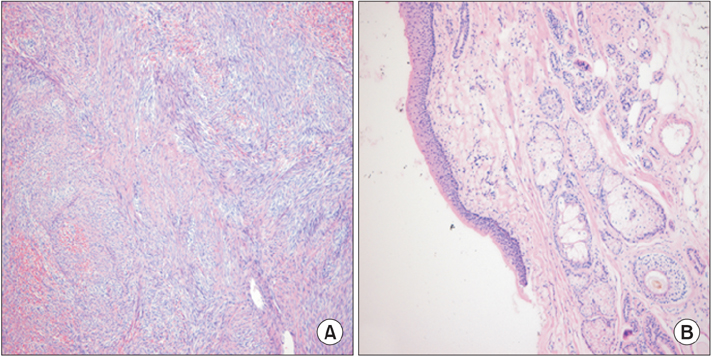J Menopausal Med.
2016 Aug;22(2):114-117. 10.6118/jmm.2016.22.2.114.
Torsion of Collision Tumor: Dermoid Cyst and Fibrothecoma with Postmenopausal Bleeding
- Affiliations
-
- 1Department of Obstetrics and Gynecology, Institute for Medical Sciences, Chonbuk National University Medical School, Jeonju, Korea. obgyn2001@jbnu.ac.kr
- KMID: 2365467
- DOI: http://doi.org/10.6118/jmm.2016.22.2.114
Abstract
- The term collision tumor refers to the coexistence of two adjacent but histological distinct tumors with no histological admixture at the interface. Collision tumors involving ovaries are extremely rare. A collision tumor composed of a dermoid cyst and fibrothecoma is extremely rare in menopausal women. The mechanism of the development of collision tumor is uncertain. During clinical evaluation, differentiation of characters of these ovarian tumors is important to decide appropriate treatment strategies and for good prognosis. We report an unusual clinical manifestation of the torsion of a dermoid cyst and fibrothecoma in the right ovary with postmenopausal bleeding.
Keyword
Figure
Cited by 1 articles
-
Multiple Synchronous Lesions in the Genital Tract of a Female: A Rare Combination with Unrelated Histogenesis
Pattomthadathil Sankaran Jayalakshmy, Faseela Kalayam Kulath, Abdul Vahab Kadavathu Parambil, Nalakath Asiq Sideeque
J Menopausal Med. 2018;24(2):133-137. doi: 10.6118/jmm.2018.24.2.133.
Reference
-
1. Pepe F, Panella M, Pepe G, et al. Dermoid cysts of the ovary. Eur J Gynaecol Oncol. 1986; 7:186–191.2. Costa MJ, Morris R, DeRose PB, et al. Histologic and immunohistochemical evidence for considering ovarian myxoma as a variant of the thecoma-fibroma group of ovarian stromal tumors. Arch Pathol Lab Med. 1993; 117:802–808.3. Kim SH, Kim YJ, Park BK, et al. Collision tumors of the ovary associated with teratoma: clues to the correct preoperative diagnosis. J Comput Assist Tomogr. 1999; 23:929–933.4. Lee SH, Kim TH, Lee HH, et al. The clinical manifestation of the gynecologic emergency in postmenopausal women. J Korean Soc Menopause. 2012; 18:119–123.5. Choi H, Kang BM, Kim JG, et al. Endometrial safety and vaginal bleeding patterns of an oral continuous combined regimens of estradiol and drospirenone for postmenopausal women: A multicenter, double blind, randomized, placebo controlled study. J Korean Soc Menopause. 2006; 12:127–133.6. Park J, Kim TH, Lee HH, et al. Endosalpingiosis in postmenopausal elderly women. J Menopausal Med. 2014; 20:32–34.7. Lee CH, Raman S, Sivanesaratnam V. Torsion of ovarian tumors: a clinicopathological study. Int J Gynaecol Obstet. 1989; 28:21–25.8. Lee EJ, Kwon HC, Joo HJ, et al. Diagnosis of ovarian torsion with color Doppler sonography: depiction of twisted vascular pedicle. J Ultrasound Med. 1998; 17:83–89.
- Full Text Links
- Actions
-
Cited
- CITED
-
- Close
- Share
- Similar articles
-
- A case of laparoscopic treatment of collision tumor: Huge serous cystadenoma and dermoid cyst arising in the same ovary
- A case of ovarian fibrothecoma with Mature teratoma of the Ipsilateral Ovary and ovarian fibroma of the contralateral Ovary
- A case of omental dermoid cyst due to an ovarian autoamputation
- Two Cases of Dermoid Cyst of Mouth Floor
- A Case of Multiple Dermoid Cyst of the Floor of the Mouth



